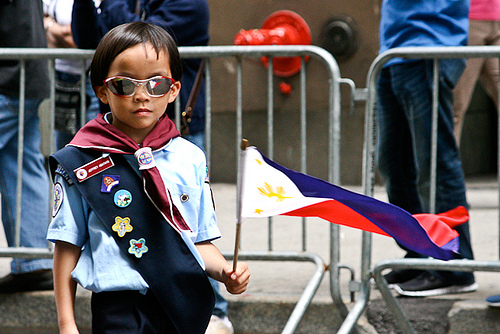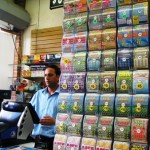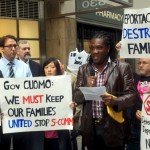Madison Avenue on June 5 was a sea of red, white and blue, the hypnotic aroma of grilled barbecue filling the air as the Filipino American community celebrated the 113th year of Philippine independence from Spain.
“The minute I walked in, it felt like I was going to a family party,” said Garrett Surie, a communication arts student at Ramapo College. “Great atmosphere.”
Organizers estimate this year’s turnout at 100,000.
“It’s overwhelming, we had to request for additional officers from the NYPD to help us control the crowd,” said festival chairperson Catherine Uy of the massive gathering that commemorated the Philippines’ declaration of sovereignty on June 12, 1898.
As the occasion was held on the same day as the Israeli Day Parade on Fifth Avenue, New York City Mayor Michael Bloomberg, Governor Andrew Cuomo, Senators Charles Schumer and Kristen Gillibrand and other officials chose to march with the Jewish community instead.
The colorful Philippine parade, stretching from 24th Street to 38th Street, appeared to mirror the country’s geography splintered into 7,000-plus islands. Filipinos marched in clusters defined by their regional origins, the universities they went to, their professions, their favorite sports, their religious affiliations, even the region in New York where they come from. There was a group from the Philippine Nurses Association of New York marching alongside the contingent from the Philippine Nurses Association of New Jersey, and yet another nurses association whose members graduated from a university in Manila.
[slideshow id=3]Photographs by Jocelyn Gonzales.
The Couples for Christ group of lay religious members had the biggest presence, attesting to the fervor of faith among Catholic Filipinos.
Filipinos who came all the way from California and Canada marched, as did children from various Tagalog language schools and employees of remittance and money transfer companies.
“It’s fun to be Filipino again,” said Irene Olegario, an office manager from Connecticut. She makes it a point to attend the parade every year to be able to hear people speak Tagalog again, and to “eat all the lovely things we never get to eat.”
“It’s a way to get back to the roots,” she said.
Filmmaker Maria Watts, whose mother is Filipino, attended the parade for the first time, her excitement tempered somewhat by the anxiety of coming face to face with the other half of her unexplored identity.
Watts, who recently moved to New York, immersed herself in an event that until recently, she didn’t know existed, having grown up in suburban West Virginia. She delighted in taking pictures of elderly Filipino women dressed in colorful gowns made of banana fiber, feasted on pork barbecue and a ‘halo-halo’ smoothie, and rolled in her tongue a few words of Tagalog. She witnessed how young Filipinos graciously helped their entrepreneurial parents set up tables to sell snacks, crafts and shirts. She made some friends.
“It’s a part of my identity I’m getting to know a little bit,” she said. There are a lot more unanswered questions in the search for her Filipino identity, and the parade, she said, was a great beginning.





